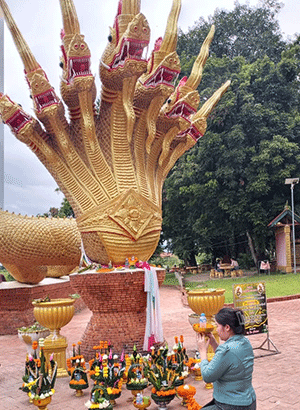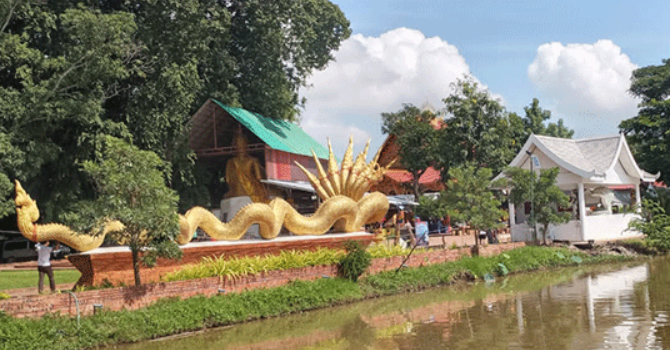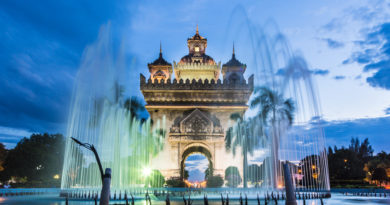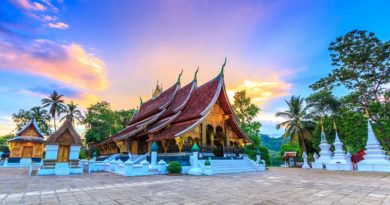Discover the Fascinating History and Legends of Nongkhamsaen Temple
Source: Vientiane Times
Nongkhamsaen temple, located in Sithan-Tai village, Hadxaifong district, Vientiane, is drawing an increasing number of visitors, who go there to pay homage while also hoping their visit will bring them good luck.
People from around Laos and even from other countries are coming to the temple to earn merit and are spreading the word about the good fortune they have experienced after making offerings there.
The temple is easy to find as it’s just 12 kilometres from the Chinaimo roundabout and can be comfortably accessed by car or motorbike along a concrete road.
After you pass Thongthat temple you will soon see the entrance to Nongkhamsaen temple on the left. A drive of almost 2 kilometres will bring you to the temple itself, near the Nongkhamsaen pond for which it is named.
People come here to pray at Naga images and the statue of Buddha. They place marigolds, candles and incense sticks around the stone serpents, while others bring colourful makbeng to place at the Buddha statue, hoping that the reverence they show will result in a change of fortune.
The temple grounds are a relaxing and peaceful place and will clear your mind. There are many large trees that provide shade, while a giant replica of a Naga draws people hoping that the presentation of offerings will bring them good luck.
Head of the Buddhist Committee in Hadxaifong district, Monk Phommalin Sisoulinthong, explained the origins of the temple, which had been passed on to him by elderly people living in the area.
The pond was also a place where people performed rituals in honour of the king and every 15th day in each month of the lunar calendar, the local people, who at that time followed the Hindu religion, invited the Naga to take part in the ceremonies.
The town that subsequently developed became known as Hadxaifong, on the outskirts of Vientiane. During the reign of King Saysetthathirath, temples, pagodas, statues and Buddha images were built around the pond and alongside the Mekong River.
This town was prosperous and contained more 100 temples and was later ruled over by King Ongsaen.
Legend has it that a Naga was born in the Nongkhamsaen pond and that the Naga King Sisattanakharat order the construction of the That Luang stupa in Vientiane during the Sisattanak era. The pond was considered sacred and can still be seen today. The temple has a huge replica of a Naga, which is viewed as the protector of Buddhism.
People living in the area sometimes ride in longboats from Nongkhamsaen pond to pray at the That Luang stupa and the Buddha images at That Luang, which are believed to have close links to the Nongkhamsaen pond.
On Buddha Day every month, it is said that a pink fireball emerges from the pond and rises into the sky, as evidence of the Naga’s continuing presence.

When the moon is full, people are banned from fishing or doing anything else in the pond. After the reign of King Saysetthathirath, the town was invaded by the Hor people, who destroyed the temple, razed the Buddha images, and stole valuables from the town and its temples. After the King heard about the war and how the town had been sacked, he flew into a rage. The Hor people were scared of his wrath and threw the valuables they had seized into the pond.
President of United Front of Sithan-Tai village, Mr Thongdaeng Phouangmalai, said the Napho and Sisouttho nagas come and go together between Nongkhamsaen temple and Khamsanod temple in Thailand.
He said that in the past Nongkhamsaen temple existed in what was known as the town of Xaifong. There was a large pond and woodlands. On the 15th day of each month in the lunar calendar people were forbidden from going to pond because it was believed the Naga was meditating. People were also not allowed to wear a red shirt when going to the pond because it might bring them bad luck.
One story recounts how a couple went fishing at the pond on this sacred day. They couldn’t catch any fish but instead saw giant snakes with red eyes and huge tails.
A change took place at Nongkhamsaen after Vientiane was flooded in 1966. People moved to higher ground to escape the flood, but even though the area changed, the place retained its reputation as a sacred site.
Why was it called Xaifong Nongkhamsaen? Buddhism replaced Hinduism as the main religion and the town of Xaifong and Nongkhamsaen pond became more closely linked with Vientiane. When the Hor people invaded, the local people had no weapons with which to fight them, so the leaders of Xaifong held a meeting to discuss ways to repel the invaders and keep their valuables safe.
It was agreed that when the moon was full, they would bring the town’s most precious items to the Nongkhamsaen pond, which was the home of the Napho Naga and known by local people as Meuangxaifong Nongkhamsaen.
Opposite the big Buddha image at the temple, they hid gold, silver and copper pagodas and in a place alongside the Mekong River called Phonetha they hid a golden boat, which then became known as Phontha-heua. The golden boat stayed there for a long time, as well as its gold paddles.
On the opposite side of the Mekong River, in a place called Vangkhong, they hid a golden khong and on every full moon the khong was struck and could be heard by all the elderly people round about.
Since being renovated a few years ago, the temple has had a facelift. A new monastery has also been built and the temple has become very popular with people both near and far.
Drawn by its history and the legends that surround it, people flock to see the temple for themselves and to learn more about its fascinating past.
Intrigued by these tales, my colleague and I decided to visit the temple.
Although I had been there in the past with relatives and friends, it was a long time since my last visit. I was surprised at the big change I found. The grounds had been paved with concrete and new accommodation for the monks and novices had been built. There were also specific places for taking photos and a display of wooden longboats.
The abbot and senior monks had clearly decided to make the temple more interesting and different from other places of worship, to encourage more people to visit. The road leading from the main road to the temple is now fully paved, making it much easier for local people to enter.
Lao and foreign Buddhist devotees come to the temple to give offerings in the hope of earning merit. Some choose to donate money or drinking water, which they believe will improve their chances of good luck in the future.
Those who believe they were rewarded with good fortune after praying at the temple sometimes make a donation towards the restoration of temple building.
The next plan is to erect a small hall in the middle of the pond, for which donations are being solicited. Dr Thongkhoun Sisaphaythong, who lives in nearby Home village, said Nongkhamsaen Temple was built during the Xaifong Kingdom at a time before the Lao Lanexang Kingdom, which held sway during the 11th-13th centuries.
He was keen for more people to learn about the history of the Xaifong Kingdom and to visit Nongkhamsaen temple.
If you do visit Nongkhamsaen temple, be sure to also visit Thongthat temple a short distance away along the Mekong River in Thongthat village, also in Hadxaifong district.
This temple has recently been renovated and is also popular with visitors, along with Nongsaen Souvannanakharam temple near the satellite station in Nahai village.
There are numerous places in Vientiane that are of historical and cultural interest to visitors. Nongkhamsaen Temple is just one of the city’s many fascinating attractions that are bound up in the country’s history and legend and draw visitors from around Laos and neighbouring countries. It is hoped that many more people will be inspired to explore Laos’ historical landmarks during Visit Laos Year 2024.
During the promotional programme, the government hopes to attract 2.7 million foreign visitors, generating US$401 million in tourism revenue.





